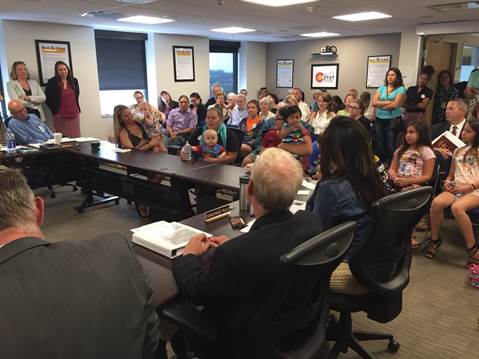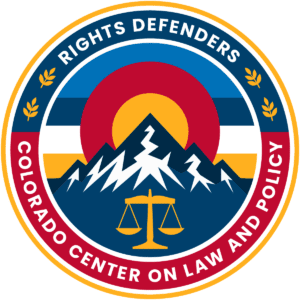CCLP's latest issue brief analyses the implications of the U.S. Supreme Court’s decision to overturn the Chevron doctrine, in conjunction with the related Corner Post decision, and current actions by the second Trump administration.
Recent articles
CCLP testifies in support of protections against junk fees
Chris Nelson provided testimony in support of House Bill 25-1090, Protections Against Deceptive Pricing Practices. CCLP is in support of HB25-1090.
CCLP testifies in support of language access in Colorado
Morgan Turner provided testimony in support of House Bill 25-1153, Statewide Government Language Access Assessment. CCLP is in support of HB25-1153, and it is one of our priority bills.
Press release: New CCLP analysis challenges claims of mass restaurant closures in Denver
A new issue brief examines recent trends in Denver’s restaurant industry and challenges claims that the city’s rising minimum wage is responsible for a significant decline in the number of restaurants.
Strong coalition elevates cash assistance for needy families

After five hours of deliberation and often emotional testimony, Colorado’s Human Services Board voted 6-2 to increase the Temporary Assistance to Needy Families (TANF) maximum monthly grant by 10 percent on Friday, July 6.
The increase — the first in nearly a decade — is a huge win for low-income families participating in Colorado Works, the state’s TANF program. This increase will become effective on Sept. 1, 2018.
This achievement was only possible because of a collective effort involving 50 endorsing organizations and leadership within the All Families Deserve a Chance Coalition, including CCLP, the Center for Work, Education and Employment (CWEE) and the Colorado Coalition for the Homeless.
During the hearing, a dozen parents from CWEE and their children shared their appreciation for TANF, while revealing the difficult financial struggles they face daily.
One mom held her baby while discussing the cost of laundry, when the child threw up on her, as if on cue. Another mom talked about trying to decide whether to use her last remaining dollars to buy diapers or tampons. Diapers won out since she is required to provide them for her child-care provider. Another mom talked about being a few dollars short on rent, which ballooned after the addition of late fees.
The current grant provides less than 27 percent of the federal poverty level to a family’s income, or $462 per month for a parent with two children. Many TANF recipients rely on the grant as their sole source of income.
Advocacy groups, social workers, faith-based leaders, and other partners provided testimony, letters of support, petitions and sign-on letters. From the Bright Future Foundation of Eagle County to Colorado Springs Food Rescue, organizational representatives lent their names and voices to support the state’s poorest families.
The coalition gathered the names of more than 140 clergy from various denominations in support of the proposal. The Colorado Children’s Campaign discussed the lasting impact of the toxic stress resulting from living in extreme poverty, and the gains in children’s health, education and future earnings that even small amount of additional income can make at such low income levels.
The Colorado Department of Human Services developed the proposal, based on budget information and caseload data. The state receives a federal TANF block group of $136 million, which is allocated to the counties.
Although the federal grant to the state has been flat since TANF was established in 1996 as part of “welfare reform,” it has lost almost 40 percent of its purchasing power since then due to the rising cost of living. Nonetheless, counties collectively fail to spend about $10 million of their TANF allocation per year. Counties retain those funds in their TANF Reserves, which have grown to more than $50 million and are approaching the maximum allowed by state law. The projected cost to counties of increasing the grant is $8 million a year.
Despite the clear and demonstrated need to raise basic cash assistance, representatives of many counties testified in strong opposition to the proposal, amid concerns that their particular county could end up spending more than their yearly allotment. Reggie Bicha, Executive Director of the Colorado Department of Human Services, countered that this could be addressed by the county-led Works Allocation Committee, which develops a distribution formula to determine the share of the TANF block grant each county receives.
Even though families enrolled in both TANF and the Supplemental Nutrition Assistance Program (SNAP) will see some reduction in their SNAP allotment due to the increase in their TANF grant, and the roughly one in four TANF recipients who also receive subsidized housing will pay a portion of that increase in the form of a rent increase, the proposal will provide significant relief for families on TANF trying to meet their basic needs. All told, it still accounts for a 4 percent increase in assistance for those who benefit from all three programs.
We appreciate the time, work and commitment of those who testified or contributed in some way to the effort.
We would also like to thank all board members for their in-depth, respectful, thoughtful insights — especially those who asked to hear from the families receiving TANF.
Finally, we’d like extend special gratitude to those parents and some of their children who shared their experiences and then waited for five hours to see their efforts pay off.
– By Chaer Robert
– Photo credit: CWEE

